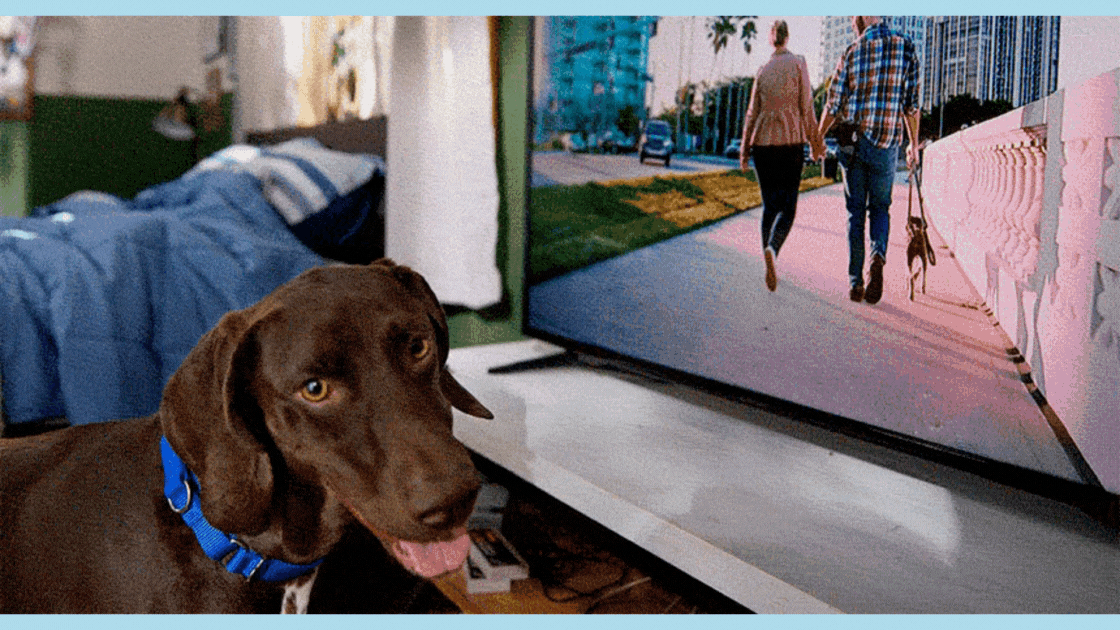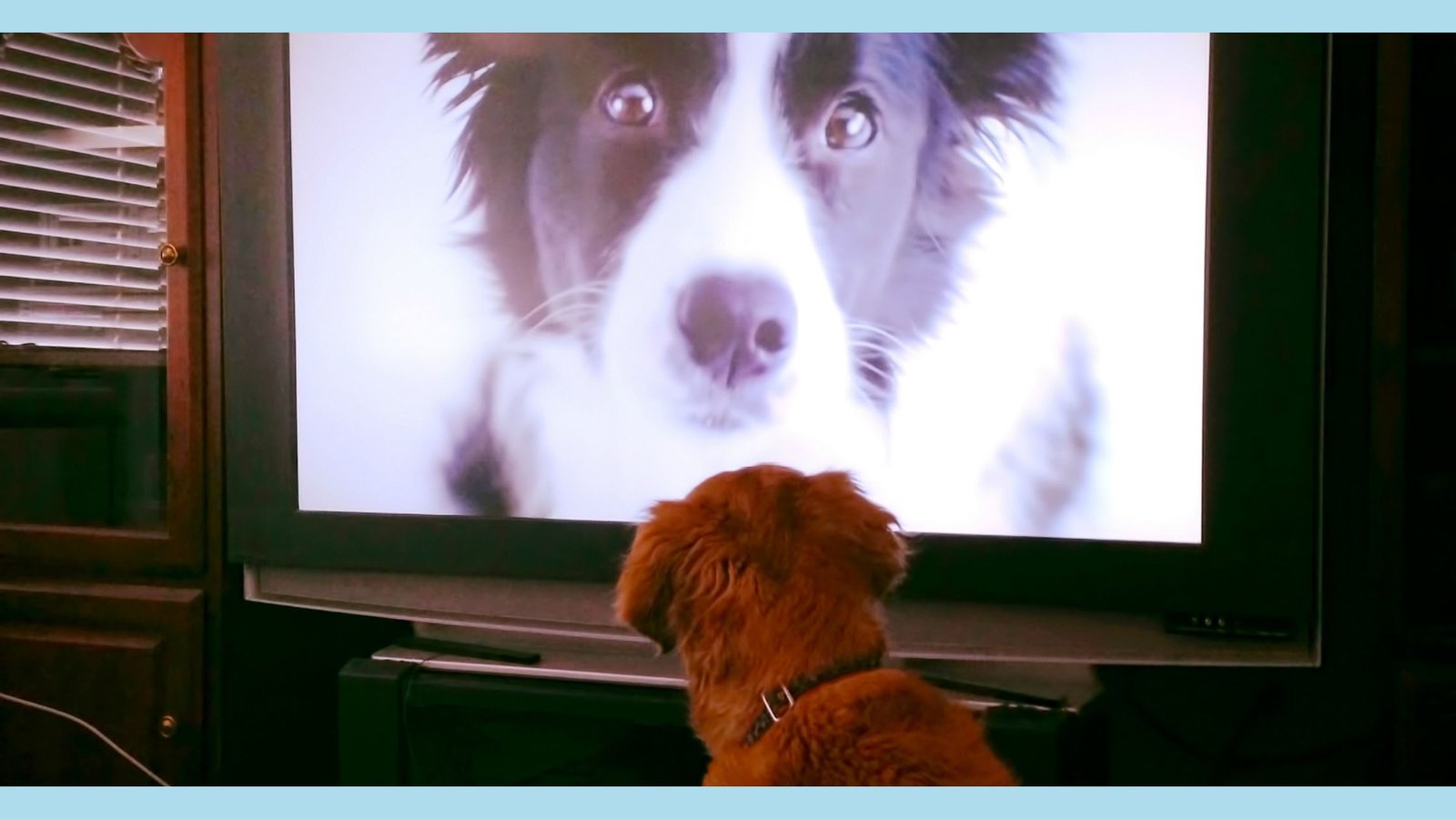
THE DOGGO TV MYSTERY
Are you curious about what goes on in your dogs mind when they watch the TV screen? Imagine stepping into the intriguing world of canine TV viewing habits and discovering how dogs perceive and interact with the visual stimuli on screens.
What dogs see on screen and how it captivates them
From understanding their dichromatic vision to unraveling their fascination with motion-filled content, this blog will delve deep into the captivating mystery of what truly captivates dogs on screen.
Stay tuned and watch the science behind dogs and TV technology, unravel the complexities of canine visual perception, and gain insights into why some dogs are more drawn to watch TV shows than others. Get ready to decode your dog’s entertainment preferences and behaviors like never before.
Understanding Dog Visual Perception
To unravel the mystery of how dogs experience television, we must first delve into their visual perception. Unlike humans, dogs possess dichromatic vision, allowing them to see shades of blue and yellow but not the full spectrum of colors. This difference in color perception is due to dogs having only two types of colour receptor cells in their retinas, compared to the three found in human eyes.
However, color isn’t the only factor influencing how dogs see the world. Their visual acuity, or sharpness of vision, is lower than that of humans, meaning objects appear less defined and more blurred to our canine companions. But what dogs lack in visual detail, they make up for in their ability to detect motion, a skill honed through their evolutionary past as skilled hunters.
🔑 Key Points: Dogs’ unique visual abilities, characterized by dichromatic color vision and heightened motion sensitivity, shape their perception of the world and their experience of television.

THE SCIENCE BEHIND DOGS AND TV TECHNOLOGY
Advancements in television technology have played a crucial role in making TV more appealing to our furry friends.
Studying canine behavior with video playback experiments
The introduction of high definition television has greatly improved image quality, offering sharper and more detailed visuals that better align with dogs’ visual capabilities. Moreover, modern TVs boast an improved flicker rate, reducing the stuttering effect of moving images and making them appear more fluid and lifelike to canine eyes.
These technological enhancements have not gone unnoticed by researchers, who have employed video playback experiments to study canine behavior and preferences. By presenting dogs with carefully crafted video images, scientists can gain valuable insights into how our four-legged companions perceive and interact with digital media.
Can Dogs Really See and Enjoy TV?
The short answer to this question is yes! As we’ve explored, domestic dogs possess the visual capabilities necessary to perceive and engage with television content. While their experience may differ from ours due to their unique visual perception, there’s no denying that many dogs show a genuine interest in the moving images and sounds emanating from the TV screen they watch.
Numerous studies and anecdotal evidence support the idea that dogs can enjoy television. From the way their ears perk up at certain sounds to the intent gaze they fix upon the screen, it’s clear that TV can capture and hold their attention. Some dogs even exhibit behaviors such as barking, tail-wagging, or attempting to interact with the on-screen action, further demonstrating their engagement with the medium.
However, it’s important to note that not all dogs respond to TV in the same way. Factors such as individual personality, age, and past experiences can influence a dog’s level of interest in television. Some may be more prone to actively watching, while others might simply enjoy the companionship and background noise provided by a TV-filled home.
Factors Influencing Dogs’ TV Enjoyment
- Individual personality and temperament
- Age and life stage
- Previous exposure to television
- Presence of engaging visual and auditory stimuli
🔑 Key Points: Dogs can indeed see and enjoy television, with their level of engagement varying based on individual factors and the nature of the content presented.

HOW DOGS PERCEIVE MOTION AND IMAGES ON SCREENS
One of the key factors that draws dogs to television is their heightened sensitivity to motion. As mentioned earlier, dogs have a superior ability to detect movement compared to humans, thanks to their evolutionary history as hunters. This motion detection prowess is precisely what makes TV so captivating for many canine viewers.
The Contrast Sensitivity Of Dogs
When a dog watches television, their attention is often drawn to the flickering images and the movement of objects or animals on the screen. This is where the concept of critical flicker fusion frequency comes into play. Dogs have a higher flicker fusion rate than humans, meaning they can perceive images as continuous motion at a higher threshold. As a result, the smoother motion rendered by modern TVs appears more lifelike and engaging to our furry friends.
However, it’s not just about the motion itself. The contrast sensitivity of dogs also plays a role in their TV-watching experience. Dogs are more attuned to differences in brightness than color, so images with high contrast and well-defined edges are more likely to catch their eye. This is why programs featuring slow-moving visuals, such as nature documentaries with sweeping landscapes and close-ups of animals, tend to be particularly appealing to canine viewers.
TV Elements That Capture Dogs’ Interest
- Fast-moving objects and animals
- High-contrast images with distinct edges
- Nature scenes and wildlife footage
- Close-ups of familiar animals or objects
🔑 Key Points: Dogs’ heightened motion detection abilities and sensitivity to contrast make them particularly drawn to slow-moving, high-contrast visuals on television screens.

DO DOGS UNDERSTAND TV IS NOT REAL?
While dogs can undoubtedly watch and enjoy TV, the question remains: do they comprehend the difference between reality and screen? Unlike humans, who can easily distinguish between real life and televised content, dogs rely heavily on their senses to navigate the world around them.
Dog’s senses and perception
One crucial factor is a dog’s sense of smell. When watching TV, dogs cannot detect the scents associated with the images they see, which may lead to confusion or disinterest. Additionally, the absence of natural sounds and the presence of unfamiliar noises coming from the TV speakers can further influence a dog’s perception of the on-screen content.
Individual Behavior Variations in Dogs that Watch TV
Just like humans, dogs exhibit individual differences in their TV-watching habits. Some dogs may be more inclined to focus on the screen, while others might show little to no interest. Factors such as age, personality, and past experiences can all contribute to these variations.
For instance, an anxious dog may find the sudden sounds and movements on TV overwhelming, leading to stress or avoidance. On the other hand, a curious and confident dog may actively engage with the on-screen content, wagging their tail and even attempting to interact with the images.
Factors Influencing Individual Differences
- Age and life stage
- Personality and temperament
- Past experiences with television
- Presence of anxiety or fear
🔑 Key Points: Dogs’ individual characteristics and experiences shape their unique responses to television, resulting in a wide range of TV-watching behaviors.

FAVORITE TV CONTENT AMONG DOGS: WHAT CAPTIVATES THEIR ATTENTION?
When it comes to the type of TV shows that captivate canine audiences, programs featuring animals and nature documentaries often reign supreme. Channels like Animal Planet and National Geographic offer a wealth of content that appeals to dogs’ visual and auditory senses. Shows that showcase other animals, particularly those with similar body language and vocalizations to dogs, can be especially engaging. The sight of a playful puppy or a majestic wolf can pique a dog’s interest, triggering their natural instincts and curiosity.
TV Shows That Appeal to Dogs
- Nature documentaries featuring animals
- Programs with slow-moving, high-contrast visuals
- Shows with familiar animal sounds and vocalizations
- Content with minimal sudden noises or loud sound effects
🔑 Key Points: TV programs that showcase animals, nature, and familiar sights and sounds are often the most appealing and relaxing for canine viewers.

THE ROLE OF SOUNDS IN ENHANCING DOGS’ TV EXPERIENCE
In addition to visuals, sounds play a crucial role in capturing dogs’ attention and enhancing their TV-watching experience. Dogs have a keen sense of hearing, allowing them to detect a wide range of frequencies and sound types. Natural sounds, such as birdsongs, rustling leaves, and animal vocalizations, can pique a dog’s interest and create a more immersive viewing experience. On the other hand, loud or sudden noises, like explosions or high-pitched beeps, may startle or distress some dogs, leading to a less enjoyable TV session.
Pros and Cons: Leaving the TV on for Your Dog?
Leaving the TV on for your dogs to watch can provide companionship and entertainment, especially when you’re away from home. However, do not forget to consider some of the potential drawbacks. Some dogs may become overly stimulated or anxious from the constant noise and stimulation. As a pet expert, it’s crucial to observe your dog’s reaction to TV and adjust accordingly, ensuring a balanced and healthy lifestyle.
The Future of Canine Screen Engagement and Research Directions
As our understanding of dog visual perception and behavior grows, so too does the potential for creating engaging and enriching TV content for dogs to watch. Future research may explore the development of dog-friendly programming, designed to cater to their unique sensory needs and preferences. By combining scientific insights with creative content production, we can continue to unravel the fascinating world of canine screen engagement.
In Summary On Can Dogs Watch TV
So shortly, this article show us the fascinating realm of dog TV viewing habits, offering a deep dive into how our furry friends perceive and engage with screens. From understanding the intricacies of canine visual perception to exploring the science behind dogs and TV technology, this blog-post has unraveled the mysteries behind why certain shows captivate our canine companions.
As we reflect on the individual behavior variations in dogs that watch TV and their favorite TV content, one thing remains clear – dogs have a unique way of experiencing the visual and auditory stimuli presented on the TV screens they watch.
The role of sounds in enhancing their TV experience and the potential benefits of leaving the TV on for them have been carefully examined, providing insights for dog owners seeking to enrich their pets’ sensory experiences. Moving forward, the future of canine screen engagement holds promising research directions, paving the way for a deeper understanding of how dogs interact with the digital world.
Thank you for joining us on this journey into the captivating world of dogs who watch TV – may your dog’s entertainment be forever enriched!

Being on this topic we would like to show you a TV Channel for Dogs and their Humans! There you can find TV shows for dogs designed to reduce anxiety and enrich their lives with thousands of relaxing on-demand videos and calming music dogs enjoy.



